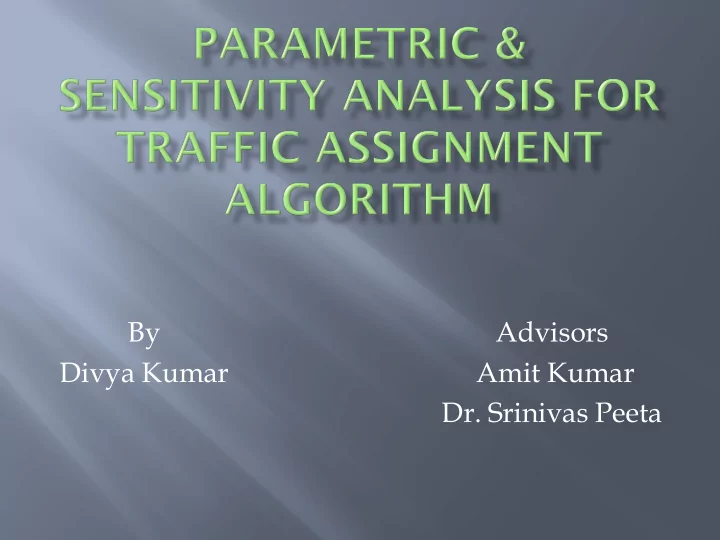

By Advisors Divya Kumar Amit Kumar Dr. Srinivas Peeta
Introduction Objective & Scope Methodology Computational Results Summary
4 Step Transportation Planning Process Trip Generation Trip Distribution Mode Choice Traffic Assignment
Traffic Assignment Given: Network Structure, Origin-Desitination (O-D) Demand, Link Performance Function Objective: To estimate the link / route flows and travel times in a network Static Traffic Assignment – Mostly used for planning purposes Dynamic Traffic Assignment
Static Traffic Assignment System Optimal Minimizes travel time of system as a whole User Equilibrium (UE) Minimizes travel time of individual users More realistic and used in the planning process
User Equilibrium (UE) Based on Wardrop’s first principle Definition of UE: “For each O-D pair, the travel times on all used paths are equal, and less than or equal to the travel time experienced by a single vehicle on any unused path” Assumptions: All users perceive travel time identically and have full knowledge of travel times on all possible routes All motorists unilaterally try to decrease their travel time At equilibrium no motorist can experience a lower travel time by unilaterally changing routes.
Solving for Static Traffic Assignment UE Link Based algorithm Origin Based algorithm Path Based algorithm Multi Path Algorithm (MPA)
Objectives: Parametric Analysis Sensitivity Analysis Scope: To identify the values of parameters of the algorithm that will get the best performance of the algorithm
Parametric Analysis Keep Scaling Factor & Demand Level Constant Change # of Inner Iterations For each Scaling Factor (0.8 – 1.6), run program for Inner Iterations 1 – 10 Record Ngap & Cpu Time for each Inner Iteration Plot graph of Ngap vs. Cpu time of all Inner Iterations for each Scaling Factor (0.8 – 1.6) Take best Inner Iteration (lowest Ngap & Cpu time) from each Scaling Factor and plot into one final graph. Repeat for remaining Demand Levels
Sensitivity Analysis For a given demand level, find the best combination of scaling factor and inner iteration Ex. For Dem. Level 0.8 (ScF. 1.1, InIt 1) is the best For the Scaling Factor & Inner Iteration obtained in step 1, plot the result of runs for all demand levels 1000 Best of Dem. Level 0.8 100 Ex. Dem0.8 Sf1.1 Init1 10 Dem1.0 Sf1.1 Init1 Ngap (Log Scale) Dem. Level 0.8 (ScF. 1.1, InIt 1) --Best 1 Dem1.2 Sf1.1 Init1 0.1 Dem. Level 1.0 (ScF. 1.1, InIt 1) 0.01 0.001 Dem. Level 1.2 (ScF. 1.1, InIt 1) 0.0001 0.00001 0 5 10 15 20 Cpu Time (sec) Repeat process for other demand levels Plot graph of Ngap vs. Cpu Time for best parameters for all demand levels
Parametric Analysis Sensitivity Analysis
Sc.Fac=1.1, Dem Lev=0.8 100 initer1 initer2 10 initer3 1 initer4 0.1 initer5 Ngap 0.01 initer6 0.001 initer7 initer8 0.0001 initer9 0.00001 initer10 0.000001 0 1 2 3 4 5 6 7 8 Cpu time (Sec)
Demand Level = 0.8 100 Sf0.5Init3 Sf0.6Init2 10 Sf0.7Init1 1 Sf0.8Init1 0.1 Sf0.9Init1 Ngap Sf1.0Init1 0.01 Sf1.1Init1 0.001 Sf1.2Init1 0.0001 Sf1.3Init1 Sf1.4Init1 0.00001 Sf1.5Init3 0.000001 0 2 4 6 8 10 12 14 Cpu time (Sec)
Demand Level = 1.0 1000 Sf0.5Init3 Sf0.6Init2 100 Sf0.7Init1 10 Sf0.8Init1 1 Sf0.9Init1 0.1 Ngap Sf1.0Init1 0.01 Sf1.1Init1 0.001 Sf1.2Init1 Sf1.3Init1 0.0001 Sf1.4Init1 0.00001 Sf1.5Init3 0.000001 0 5 10 15 20 25 30 35 40 Cpu time (Sec)
Demand Level = 1.2 1000 Sf0.5Init3 Sf0.6Init2 100 Sf0.7Init1 10 Sf0.8Init1 1 Sf0.9Init1 0.1 Ngap Sf1.0Init1 0.01 Sf1.1Init1 0.001 Sf1.2Init1 Sf1.3Init1 0.0001 Sf1.4Init1 0.00001 Sf1.5Init3 0.000001 0 5 10 15 20 25 30 35 Cpu time (Sec)
1000 1000 Best of Dem. Level 0.8 Best of Dem. Level 1.0 100 100 Dem0.8 Sf1.1 Dem0.8 Sf1.5 Init1 10 Init3 10 Ngap (Log Scale) Dem1.0 Sf1.1 Ngap (Log Scale) 1 Dem1.0 Sf1.5 1 Init1 Init3 Dem1.2 Sf1.1 0.1 0.1 Dem1.2 Sf1.5 Init1 0.01 Init3 0.01 0.001 0.001 0.0001 0.0001 0.00001 0.00001 0.000001 0 5 10 15 20 0 5 10 15 20 25 30 35 Cpu Time (sec) Cpu Time (sec) 1000 Best of Dem. Level 1.2 100 Dem0.8 Sf1.4 10 Init1 Ngap (Log Scale) Dem1.0 Sf1.4 1 Init1 0.1 Dem1.2 Sf1.4 Init1 0.01 0.001 0.0001 0.00001 0.000001 0 5 10 15 20 25 Cpu Time (sec)
Best of All Dem. Levels 1000 100 Dem0.8 Sf1.1 Init1 10 Dem1.0 Sf1.5 Init3 Ngap (Log Scale) 1 Dem1.2 Sf1.4 Init1 0.1 0.01 0.001 0.0001 0.00001 0.000001 0 5 10 15 20 25 Cpu Time (sec)
The performance of the Multi Path Algorithm (MPA) depends on Scaling Factor and # of Inner Iterations The best performance of MPA for demand level 1 was found at the scaling factor of 1.5 The performance of the MPA is also sensitive to the level of demand With the increase in demand level, the required Cpu time to achieve convergence increases
Thank You
Recommend
More recommend